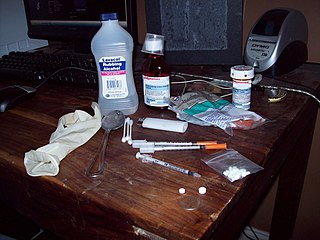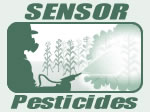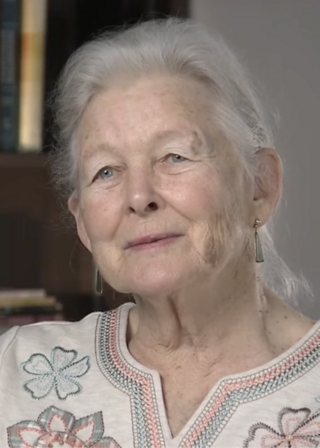
A blood-borne disease is a disease that can be spread through contamination by blood and other body fluids. Blood can contain pathogens of various types, chief among which are microorganisms, like bacteria and parasites, and non-living infectious agents such as viruses. Three blood-borne pathogens in particular, all viruses, are cited as of primary concern to health workers by the CDC-NIOSH: HIV, hepatitis B (HVB), & hepatitis C (HVC).

Occupational therapy (OT) is a healthcare profession. It involves the use of assessment and intervention to develop, recover, or maintain the meaningful activities, or occupations, of individuals, groups, or communities. The field of OT consists of health care practitioners trained and educated to improve mental and physical performance. Occupational therapists specialize in teaching, educating, and supporting participation in any activity that occupies an individual's time. It is an independent health profession sometimes categorized as an allied health profession and consists of occupational therapists (OTs) and occupational therapy assistants (OTAs). While OTs and OTAs have different roles, they both work with people who want to improve their mental and or physical health, disabilities, injuries, or impairments.

The National Institute for Occupational Safety and Health is the United States federal agency responsible for conducting research and making recommendations for the prevention of work-related injury and illness. NIOSH is part of the Centers for Disease Control and Prevention (CDC) within the U.S. Department of Health and Human Services. Despite its name, it is not part of either the National Institutes of Health nor OSHA. Its current director is John Howard.
Occupational medicine, until 1960 called industrial medicine, is the branch of medicine which is concerned with the maintenance of health in the workplace, including prevention and treatment of diseases and injuries, with secondary objectives of maintaining and increasing productivity and social adjustment in the workplace.
Injury prevention is an effort to prevent or reduce the severity of bodily injuries caused by external mechanisms, such as accidents, before they occur. Injury prevention is a component of safety and public health, and its goal is to improve the health of the population by preventing injuries and hence improving quality of life. Among laypersons, the term "accidental injury" is often used. However, "accidental" implies the causes of injuries are random in nature. Researchers prefer the term "unintentional injury" to refer to injuries that are nonvolitional but often preventable. Data from the U.S. Centers for Disease Control show that unintentional injuries are a significant public health concern: they are by far the leading cause of death from ages 1 through 44. During these years, unintentional injuries account for more deaths than the next three leading causes of death combined. Unintentional injuries also account for the top ten sources of nonfatal emergency room visits for persons up to age 9 and nine of the top ten sources of nonfatal emergency room visits for persons over the age of 9.
The National Occupational Research Agenda (NORA) is a partnership program developed by the National Institute for Occupational Safety and Health (NIOSH). The program was founded in 1996 to provide a framework for research collaborations among universities, large and small businesses, professional societies, government agencies, and worker organizations. Together these parties identify issues in the field of workplace safety and health that require immediate attention based on the number of workers affected, the seriousness of the hazard, and the likelihood that new safety information and approaches can effect a change.

The Journal of Health and Social Behavior is a quarterly peer-reviewed academic journal published by SAGE Publications on behalf of the American Sociological Association. It covers the application of sociological concepts and methods to the understanding of health and illness and the organization of medicine and health care. The editor-in-chief is Amy Burdette. Previous editors-in-chief include Richard M. Carpiano, Brian C. Kelly, Gilbert Gee, Debra Umberson, and Eliza Pavalko.

The Journal of Occupational Health Psychology is a peer-reviewed academic journal published bimonthly by the American Psychological Association. It "publishes research, theory, and public policy articles in occupational health psychology, an interdisciplinary field representing a broad range of backgrounds, interests, and specializations. Occupational health psychology concerns the application of psychology to improving the quality of work life and to protecting and promoting the safety, health, and well-being of workers." The current editor-in-chief is Sharon Clarke, PhD.

Sentinel Event Notification System for Occupational Risks (SENSOR)-Pesticides is a U.S. state-based surveillance program that monitors pesticide-related illness and injury. It is administered by the National Institute for Occupational Safety and Health (NIOSH), twelve state health agencies participate. NIOSH provides technical support to all participating states. It also provides funding to some states, in conjunction with the US Environmental Protection Agency.
Cancer Epidemiology, Biomarkers & Prevention is a peer-reviewed medical journal devoted to research in the field of cancer epidemiology. Topics include descriptive, analytical, biochemical, and molecular epidemiology, the use of biomarkers to study the neoplastic and preneoplastic processes in humans, chemoprevention and other types of prevention trials, and the role of behavioral factors in cancer etiology and prevention. It is published by the American Association for Cancer Research and co-sponsored by the American Society of Preventive Oncology.
Preventive Medicine is a peer-reviewed medical journal published by Elsevier since 1972. It covers all aspects of preventive medicine and public health. The editor-in-chief is Eduardo L. Franco. The founding editor was Ernst Wynder.

American Journal of Men's Health, is a peer-reviewed academic journal that publishes papers in the field of Health. The journal's editor is Demetrius James Porche. It has been in publication since 2007 and is currently published by SAGE Publications.

Indoor and Built Environment is a peer-reviewed academic journal covering any topic pertaining to the quality of the indoor and built environment and how this affects the efficiency, performance, health, and comfort of those living or working there. Topics range from urban infrastructure, design of buildings, and materials used for laboratory studies including building airflow simulations and health effects. The editor-in-chief is Chuck Yu. It was established in 1992 by consultants to the tobacco company Philip Morris, and is published by SAGE Publications.

Occupational safety and health (OSH), also commonly referred to as occupational health and safety (OHS), occupational health, or occupational safety, is a multidisciplinary field concerned with the safety, health, and welfare of people at work. These terms also refer to the goals of this field, so their use in the sense of this article was originally an abbreviation of occupational safety and health program/department etc.
The Journal of Adolescent Health is a peer-reviewed medical journal covering adolescent health and medicine, including biological, psychological, and social aspects. The journal publishes original research articles, review articles, letters to the editor, commentaries, and case reports. It is published by Elsevier on behalf of the Society for Adolescent Health and Medicine, and was established in 1980 as the Journal of Adolescent Health Care, switching to its current name in 1991. Carol A. Ford has been the editor-in-chief since 2019.

Dinesh Mohan was honorary professor at Indian Institute of Technology Delhi since 2017. He was distinguished professor at Shiv Nadar University, Gautam Buddha Nagar (India) from 2016 to 2018. From 2010 to 2015 he was Emeritus Volvo Chair Professor for Transportation Planning & Safety at IITD. He was head of Centre for Biomedical Engineering (1991–1996), Coordinator of the Transportation Research and Injury Prevention Programme (1998–2010) and head, W.H.O. Collaborating Centre for Research and Training in Safety Technology at IIT Delhi (1991–2010). He was also Director, Independent Council for Road Safety International (www.icorsi.org).
Prevention Science is a peer-reviewed public health journal covering prevention science.
The International Journal of Occupational and Environmental Health was a quarterly peer-reviewed public health journal with a focus on occupational and environmental health. It was established in 1995 and was published by Routledge. The last editor-in-chief was Andrew Maier.
Community Dentistry and Oral Epidemiology is a bimonthly peer-reviewed medical journal covering dental public health and the application of epidemiology to dentistry. It was established in 1973 and is published by John Wiley & Sons. The editor-in-chief is Professor Sarah R Baker. According to the Journal Citation Reports, the journal has a 2020 impact factor of 3.383, ranking it 26th out of 91 journals in the category "Dentistry, Oral Surgery & Medicine" and 69th out of 203 in the category "Public, Environmental & Occupational Health".

Susan Pardee Baker is a professor emeritus of health policy and management at the Johns Hopkins Bloomberg School of Public Health and a injury prevention expert. She served as the first director of the Johns Hopkins Center for Injury Research and Policy. She is also known for developing Injury Severity Scores.









